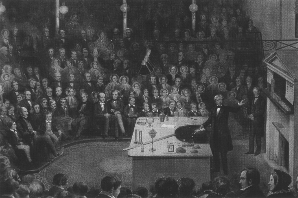
Natural Science - Year II
Unit 52: Maxwell and Electromagnetic Radiation

History Weblecture for Unit 52
| This Unit's | Homework Page | History Lecture | Science Lecture | Lab | Parents' Notes |
History Lecture for Unit 52: Maxwell and Electromagnetic Radiation
For Class
- Period: 1650-1900
For the interactive timelines, click on an image to bring it into focus and read notes.
Click on the icon to bring up the timeline in a separate browser window. You can then resize the window to make it easier to read the information.Click here: Timeline PDF to bring up the timeline as a PDF document. You can then click on the individual events to see more information if you want. Exploring this version of the timeline is optional!
- Geographic Location: Europe, the United States
- People to know: James Clerk Maxwell
- See science topics: Electromagnetic Radiation
Outline/Summary
Maxwell's synthesis: Electricity and Magnetism
Faraday's and Henry's work made it possible to control current flow in circuits, which opened up opportunities for more experimentation. The German Gustav Kirchhoff identified rules which allowed him to predict how different circuit configurations would affect voltage and current. He realized that electrical signals in wire propagate at the speed of light, even though individual electrons move at much slower speeds.
James Clerk Maxwell
These new observations, along with the information Faraday had already collected on polarized light in magnetic fields, gave James Clerk Maxwell some ideas about the relationship between electromagnetic phenomena and light.
Maxwell was a mathematician, trained at Edinburgh University in Scotland. He used mathematics to create models of physical systems and describe their limitations. One of his first analyses showed that Saturn's rings had to be made of small particles capable of individual movement at different speeds, because a solid object of the ring's size and shape would be torn apart by Saturn's gravitational field.
Aided by his wife, Maxwell performed a number of experiments on gas, color, and electromagnetic forces. He proposed that magnetism was the result of spinning molecules, which he called molecular vortices. The direction and speed of rotation of a vortex determined the intensity of its magnetic force. Using calculus to sum up the contributions of individual particles to an overall field, he was finally able to explain electromagnetic phenomena in precise mathematical terms .
Maxwell's Equations
Today, Maxwell's equations are considered the prime example of elegance, the physicist's term for a supremely simple mathematical relationship between basic natural concepts. All electromagnetic phenomena can be explained using one or more his his four equations, which are generalizations of the discoveries of his predecessors. These are
- Coulomb's law of electricity, which we've already seen as F = k q Q/ r2(This is sometimes called Gauss's law of electricity, because Gauss give it its current mathematical form). In Maxwell's generalized form, the total electric field strength from a point charge is measured by considering the electric potential which crosses a given area. This quantity, called the electric flux, depends on the area and the magnitude of the charge involved.
- A force law for magnetism. This is analogous to Coulomb's law of electricity, but because magnetic poles cannot be separated, a magnetic field is always the result of two poles of magnetism. Maxwell determined that the magnetic flux through any area from a given magnet was zero, because of the presence of both poles in all cases.
- Faraday's law of inductance states that a changing magnetic field creates an electric field. Maxwell's equation for this law shows that the magnitude of the induced electrical field depends on the rate at which the magnetic field is changing.
- Ampère's law predicts that a changing electric field (generated by current flowing through a coil) should create a magnetic field. Maxwell's equation for this law shows that the strength of the magnetic field depends both on the amount of current and on the rate at which the electric field generated by the current is changing.
Notice that the last two laws reinforce each other: a changing magnetic field generates an electrical field, a changing electrical field generates a magnetic field, so the size or amplitude of the fields will oscillate (get bigger and smaller in a wave-like manner). A medium (the material through which the wave travels) can support the induction of magnetic and electrical fields in a specific amount, called the permittivity of the medium for electricity and the permeability of the medium for magnetism. The quantities of permittivity and permeability had been determined earlier for free space or vacuum. Maxwell realized that if he inserted them into his last two equations, he could predict the speed of the electromagnetic wave as 3.0 * 108 meters/sec. This coincided exactly for the independently—determined speed of light. Maxwell proclaimed in his Treatise on Electricity and Magnetism, published in 1873, that light was the result of electromagnetic wave propagation.
Read about James Maxwell at the St. Andrews Mathematics site.
- What were Maxwell's achievements in mathematics? in physics? in astronomy?
- What work did Maxwell do on the nature of gases? Who else worked on this subject?
Study/Discussion Questions:
- The Maxwell-Boltzmann theory of gases is an example of simultaneous discovery. Why do you think there are so many similar situations, where more than one person makes the same discovery at roughly the same time?
Further Study/On Your Own
- Here's a brief history of the measurement of the speed of light.
© 2005 - 2024 This course is offered through Scholars Online, a non-profit organization supporting classical Christian education through online courses. Permission to copy course content (lessons and labs) for personal study is granted to students currently or formerly enrolled in the course through Scholars Online. Reproduction for any other purpose, without the express written consent of the author, is prohibited.